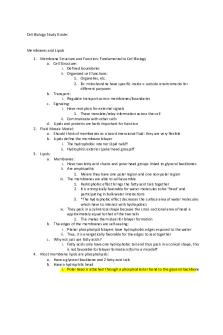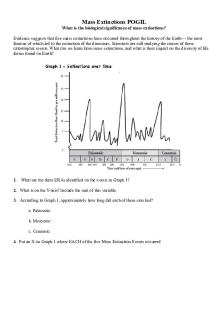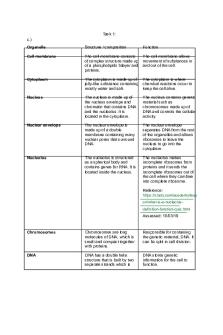Principles of Cell Biology Case Study 2 Parts II and III PDF

| Title | Principles of Cell Biology Case Study 2 Parts II and III |
|---|---|
| Author | John Fragale |
| Course | Principles Of Cell Biology |
| Institution | Binghamton University |
| Pages | 3 |
| File Size | 69.2 KB |
| File Type | |
| Total Downloads | 103 |
| Total Views | 128 |
Summary
Attached is assignment examples and helpful keys in understanding the second case study for Principles of Cell Biology Case Study 2 Parts II and III...
Description
John Fragale Biology 311 Case Study 2: Parts II and III 10/10/2021
Part II – Diabetes and Insulin Signaling 1. How could the study of insulin signaling help people with diabetes? a. The study of insulin signaling could help people with diabetes as a deeper understanding would allow for development of better diabetes treatment or management strategies. Also, understanding underlying causes for diabetes can also allow for better prediction of at-risk groups. Studying the mechanisms of insulin signaling can help researchers discover a potential way to influence certain proteins so that the functional GLUT4 can reach the plasma membrane. They can also do more research on how secondary messengers within the insulin signaling pathway can be manipulated. 2. Why does it make sense that Mia’s grandfather may be more fatigued than a nondiabetic? a. When the body is not capable of utilizing glucose as energy to in turn make a hefty amount of ATP this affects fatigue. The process of cellular respiration is not as effective and is slower. Due to this, his cells cannot synthesize the ATP and in turn has to resort to breaking down proteins and fats. When his body has to rely on these sources for energy instead of glucose, the body can produce unwanted byproducts such as: diminished sensory perception, higher risk of infection on feet, and low blood pH. All of these byproducts negatively impact Mia's grandfather's health and physiology. 3. Examine the figure of insulin signaling. Why does one receptor have so many different signal transduction proteins/pathways? a. All cells respond to signals, and cells accommodate based on the environment and signal they receive. Because they respond and make both long and short term changes, a variety of transduction proteins and pathways ensures that each signal is responded to and that multiple responses are generated if need be. 4. How does a lack of insulin prevent the cell from using glucose? a. A lack of insulin can result in less GLUT4 on the plasma membrane. This can result in cell glucose inside the cytoplasm. Glucose needs the assistance of channel proteins in order to cross the membrane, as it is too large and polar to diffuse on its own. 5. Why is it important that specific tissues respond to insulin in different ways? a. A great amount of the cells in the human body hold near 25,000 genes. Each cell type, which comply with different tissues, express different sets of genes. Different tissues have the ability to create similar insulin receptor proteins and
sometimes even the same one; however, the produce different secondary messengers, kinase enzymes, and transcription factors - resulting in varying responses. A single response in a certain tissue could respond with the conversion of glucose into glycogen while a separate response could be a gene expression that is atypical. This variety strongly influences the behavior of varying cell types. 6. Hypothesize a mechanism to explain how tissues respond to insulin in different ways, even tissues that have the same amount of the receptor. a. Because different cell types adjust to different tissues, they generally have different kinases, secondary messengers, etc. This leads to different responses to insulin regardless of the amount of receptor.
Part III – Insulin Resistance 1. What is the general purpose of feedback inhibition? What is the problem if feedback inhibition happens when it isn’t supposed to? a. The purpose of feedback inhibition is regulating the concentration of compounds within a cell. If this occurs when it doesn't need to, the concentration being regulated may lower and become detrimental to the cell health. Elevated levels of insulin decrease blood glucose levels. Low blood glucose inhibits release of insulin through the pancreas. 2. How do the effects of insulin resistance compound to decrease cellular responses to insulin? a. Because there was not as much uptake of glucose to the bloodstream, the levels of glucose stayed elevated. This causes the pancreatic cells to release insulin which in turn can affect the function of the transduction pathway. Too much insulin production can also inhibit further production of insulin. 3. Hypothesize a mechanism by which the GLUT4 transporter’s fusion to the cell membrane could be decreased. a. GLUT4 may not be able to fit within the vesicle membrane due to a number of scenarios. Misfolded or messed up enzymes that have been deactivated, or the cytoplasmic domain may fail to phosphorylate once it has bound to the insulin all meaning that secondary messengers won't be produced within the right area and conditions. 4. Consider the possible projects that Mia could study. a. Which project would you pick? i. The project I’d pick is ‘Diabetes and Insulin Signaling.’ b. Why do you think this project is important? i. I think this project is important because it is the foundation of the many other projects that Mia is exploring. It is particularly important for Mia’s case because it directly impacts a family member in her life. This project also is significant for a deeper understanding into the mechanisms of diabetes.
c. What kind of experiments would you do? i. Some possible experiments could look into the effects of diabetes and insulin signaling into college students. I would be particularly interested into studying the differences in the eating habits among different college campuses to see if the food provided by the campus affects the dietary consumption of these populations. This study can be analyzed over the four year collegiate career of these students....
Similar Free PDFs

Cell Biology Study Guide
- 37 Pages

Cell biology and genetics
- 12 Pages

Cell and molecular biology
- 16 Pages

Principles of Biology BIO120
- 2 Pages

Case Study 3 - iii
- 3 Pages

Cell biology
- 3 Pages

MCQ ON CELL Biology PART II
- 5 Pages
Popular Institutions
- Tinajero National High School - Annex
- Politeknik Caltex Riau
- Yokohama City University
- SGT University
- University of Al-Qadisiyah
- Divine Word College of Vigan
- Techniek College Rotterdam
- Universidade de Santiago
- Universiti Teknologi MARA Cawangan Johor Kampus Pasir Gudang
- Poltekkes Kemenkes Yogyakarta
- Baguio City National High School
- Colegio san marcos
- preparatoria uno
- Centro de Bachillerato Tecnológico Industrial y de Servicios No. 107
- Dalian Maritime University
- Quang Trung Secondary School
- Colegio Tecnológico en Informática
- Corporación Regional de Educación Superior
- Grupo CEDVA
- Dar Al Uloom University
- Centro de Estudios Preuniversitarios de la Universidad Nacional de Ingeniería
- 上智大学
- Aakash International School, Nuna Majara
- San Felipe Neri Catholic School
- Kang Chiao International School - New Taipei City
- Misamis Occidental National High School
- Institución Educativa Escuela Normal Juan Ladrilleros
- Kolehiyo ng Pantukan
- Batanes State College
- Instituto Continental
- Sekolah Menengah Kejuruan Kesehatan Kaltara (Tarakan)
- Colegio de La Inmaculada Concepcion - Cebu








